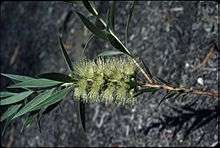Melaleuca formosa
| Kingaroy bottlebrush | |
|---|---|
 | |
| Scientific classification | |
| Kingdom: | Plantae |
| Clade: | Angiosperms |
| Clade: | Eudicots |
| Clade: | Rosids |
| Order: | Myrtales |
| Family: | Myrtaceae |
| Genus: | Melaleuca |
| Species: | M. formosa |
| Binomial name | |
| Melaleuca formosa | |
| Synonyms[1] | |
|
| |
Melaleuca formosa, commonly known as Kingaroy bottlebrush or cliff bottlebrush is a plant in the myrtle family, Myrtaceae and is endemic to a small area in Queensland, Australia. (Some Australian state herbaria continue to use the name Callistemon formosus.)[2] It is a shrub with weeping branches and spikes of lemon-coloured flowers in spring.
Description
Melaleuca formosa is a spreading shrub growing to 2–6 m (7–20 ft) tall. Its leaves are arranged alternately and are 35–86 mm (1–3 in) long, 3–9 mm (0.1–0.4 in) wide, flat, narrow egg-shaped or narrow elliptical with a mid-vein and have distinct oil glands and 11 to 24 branching veins.[1]
The flowers are whitish through cream to lime-green and arranged in spikes on the ends of branches which continue to grow after flowering as well as on the sides of the branches. The spikes are up to 45 mm (2 in) in diameter with 20 to 40 individual flowers. The petals are 3.5–4.5 mm (0.14–0.18 in) long and fall off as the flower ages. There are 57 to 63 stamens in each flower, tipped with yellow. Flowering occurs throughout the year but mainly in spring and is followed by fruit which are woody capsules, 3.8–5.4 mm (0.1–0.2 in) long.[1][3]
Taxonomy and naming
Melaleuca formosa was named in 2006 by Lyndley Craven in Novon.[4][5] It had previously been known as Callistemon formosus having first been formally described in 1958 by S.T.Blake in Proceedings of the Royal Society of Queensland from a specimen found "near Kingaroy (near Edenvale Rwy. Stn.), low plateau, remnant of mixed low forest on red loam."[6] The specific epithet (formosa) is a Latin word meaning “beautifully formed” or "handsome"[7] referring to the appearance of the plant.[1]
Callistemon formosus is regarded as a synonym of Melaleuca formosa by the Royal Botanic Gardens, Kew.[8]
Distribution and habitat
This melaleuca occurs in near coastal districts in south eastern Queensland where it grows in vine forest or as an understorey plant beneath eucalypts in loam or sandy soil over trachyte.[1]
Conservation
Melaleuca formosa is classified as "near threatened" under the Government of Queensland Nature Conservation Act (1992).[9]
Use in horticulture
Melaleuca formosa is grown as a street tree in Kingaroy.[3] It is recommended as a shrub to be grown under powerlines[10] and has been found to be relatively tolerant to the fungal disease, myrtle rust (Uredo rangelii).[11]
References
- 1 2 3 4 5 Brophy, Joseph J.; Craven, Lyndley A.; Doran, John C. (2013). Melaleucas : their botany, essential oils and uses. Canberra: Australian Centre for International Agricultural Research. p. 171. ISBN 9781922137517.
- ↑ Udovicic, Frank; Spencer, Roger (2012). "New combinations in Callistemon (Myrtaceae)" (PDF). Muelleria. 30 (1): 23–25. Retrieved 11 June 2015.
- 1 2 "Bottlebrush - genus Callistemon". Australian National Botanic Garden. Retrieved 14 June 2015.
- ↑ "Melaleuca formosa". APNI. Retrieved 14 June 2015.
- ↑ Craven, Lyn A. (2006). "New Combinations in Melaleuca for Australian Species of Callistemon (Myrtaceae)". Novon. 16 (4): 472. doi:10.3417/1055-3177(2006)16[468:NCIMFA]2.0.CO;2. Retrieved 14 June 2015.
- ↑ "Callistemon formosus". APNI. Retrieved 14 June 2015.
- ↑ Brown, Roland Wilbur (1956). The Composition of Scientific Words. Washington, D.C.: Smithsonian Institution Press. p. 346.
- ↑ "Callistemon formosus". World Checklist of Selected Plant Families (WCSP). Royal Botanic Gardens, Kew.
- ↑ "Mount Walsh National Park Management Statement" (PDF). Queensland Government Department of National Parks, Recreation, Sport and Racing. Retrieved 14 June 2015.
- ↑ "Think smart, plant smart" (PDF). Ergon Energy. Archived from the original (PDF) on 5 April 2015. Retrieved 14 June 2015.
- ↑ "Myrtle Rust Management Plan (2012)" (PDF). Nursery and Garden Industry. Retrieved 14 June 2015.